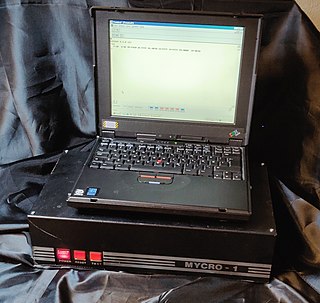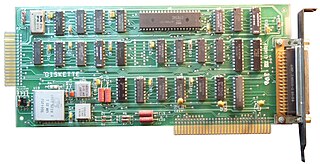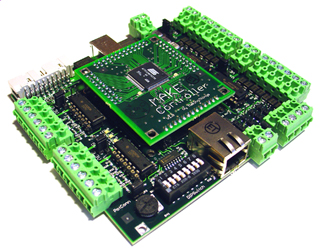
The Intel 8080 ("eighty-eighty") is the second 8-bit microprocessor designed and manufactured by Intel. It first appeared in April 1974 and is an extended and enhanced variant of the earlier 8008 design, although without binary compatibility. Although earlier microprocessors were commonly used in mass-produced devices such as calculators, cash registers, computer terminals, industrial robots, and other applications, the 8080 saw greater success in a wider set of applications, and is largely credited with starting the microcomputer industry.

A microcomputer is a small, relatively inexpensive computer having a central processing unit (CPU) made out of a microprocessor. The computer also includes memory and input/output (I/O) circuitry together mounted on a printed circuit board (PCB). Microcomputers became popular in the 1970s and 1980s with the advent of increasingly powerful microprocessors. The predecessors to these computers, mainframes and minicomputers, were comparatively much larger and more expensive. Many microcomputers are also personal computers. An early use of the term "personal computer" in 1962 predates microprocessor-based designs. (See "Personal Computer: Computers at Companies" reference below). A "microcomputer" used as an embedded control system may have no human-readable input and output devices. "Personal computer" may be used generically or may denote an IBM PC compatible machine.

The Intel 8085 ("eighty-eighty-five") is an 8-bit microprocessor produced by Intel and introduced in March 1976. It is the last 8-bit microprocessor developed by Intel.

Mycron was a pioneer manufacturer of microcomputers, located in Oslo, Norway.

The Osborne 1 is the first commercially successful portable computer, released on April 3, 1981 by Osborne Computer Corporation. It weighs 24.5 lb (11.1 kg), cost US$1,795, and runs the CP/M 2.2 operating system. It is powered from a wall socket, as it has no on-board battery, but it is still classed as a portable device since it can be hand-carried when the keyboard is closed.

The Datapoint 2200 was a mass-produced programmable terminal usable as a computer, designed by Computer Terminal Corporation (CTC) founders Phil Ray and Gus Roche and announced by CTC in June 1970. It was initially presented by CTC as a versatile and cost-efficient terminal for connecting to a wide variety of mainframes by loading various terminal emulations from tape rather than being hardwired as most contemporary terminals, including their earlier Datapoint 3300.

The Rainbow 100 is a microcomputer introduced by Digital Equipment Corporation (DEC) in 1982. This desktop unit had a monitor similar to the VT220 and a dual-CPU box with both 4 MHz Zilog Z80 and 4.81 MHz Intel 8088 CPUs. The Rainbow 100 was a triple-use machine: VT100 mode, 8-bit CP/M mode, and CP/M-86 or MS-DOS mode using the 8088. It ultimately failed to succeed in the marketplace which became dominated by the simpler IBM PC and its clones which established the industry standard as compatibility with CP/M became less important than IBM PC compatibility. Writer David Ahl called it a disastrous foray into the personal computer market. The Rainbow was launched along with the similarly packaged DEC Professional and DECmate II which were also not successful. The failure of DEC to gain a significant foothold in the high-volume PC market would be the beginning of the end of the computer hardware industry in New England, as nearly all computer companies located there were focused on minicomputers for large organizations, from DEC to Data General, Wang, Prime, Computervision, Honeywell, and Symbolics Inc.

A floppy-disk controller (FDC) is a hardware component that directs and controls reading from and writing to a computer's floppy disk drive (FDD). It has evolved from a discrete set of components on one or more circuit boards to a special-purpose integrated circuit or a component thereof. An FDC is responsible for reading data presented from the host computer and converting it to the drive's on-disk format using one of a number of encoding schemes, like FM encoding or MFM encoding, and reading those formats and returning it to its original binary values.

Processor Technology Corporation was a personal computer company founded in April 1975, by Gary Ingram and Bob Marsh in Berkeley, California. Their first product was a 4K byte RAM board that was compatible with the MITS Altair 8800 computer but more reliable than the MITS board. This was followed by a series of memory and I/O boards including a video display module.

The Z-89 is a personal computer introduced in 1979 by Heathkit, but produced primarily by Zenith Data Systems (ZDS) in the early 1980s. It combined an updated version of the Heathkit H8 microcomputer and H19 terminal in a new case that also provided room for a built-in floppy disk on the right side of the display. Based on the Zilog Z80 microprocessor it is capable of running CP/M as well as Heathkit's own HDOS.
George Morrow was part of the early microcomputer industry in the United States. Morrow promoted and improved the S-100 bus used in many early microcomputers. Called "one of the microcomputer industry's iconoclasts" by Richard Dalton in the Whole Earth Software Catalog, Morrow ran his own computer business, Thinker Toys, Inc., later Morrow Designs. He was also a member of the Homebrew Computer Club.

The Dick Smith Super-80 was a Zilog Z80 based kit computer developed as a joint venture between Electronics Australia magazine and Dick Smith Electronics.
CADO Systems was a minicomputer and software manufacturer in 1976. In 1983 was acquired by Contel Business Systems. In 1989, Contel Business Systems merged with NDS and became VERSYSS. CADO was formed by former staff of McDonnell-Douglas Information Systems. CADO was based in Torrance, California and had a manufacturing plant and systems software engineering team in Cork, Ireland.

A single-board microcontroller is a microcontroller built onto a single printed circuit board. This board provides all of the circuitry necessary for a useful control task: a microprocessor, I/O circuits, a clock generator, RAM, stored program memory and any necessary support ICs. The intention is that the board is immediately useful to an application developer, without requiring them to spend time and effort to develop controller hardware.
PolyMorphic Systems was a manufacturer of microcomputer boards and systems based on the S-100 bus. Their products included the Poly-88 and the System 8813. The company was incorporated in California in 1976 as Interactive Products Corporation d/b/a PolyMorphic Systems. It was initially based in Goleta, then Santa Barbara, California.

The P8000 is a microcomputer system developed in 1987 by the VEB Elektro-Apparate-Werke Berlin-Treptow „Friedrich Ebert“ (EAW) in the German Democratic Republic. It consisted of an 8-bit and a 16-bit microprocessor and a Winchester disk controller. It was intended as a universal programming and development system for multi-user/multi-task applications. The initial list price of the P8000 was 172,125 East German marks.
The NEC μCOM series is a series of microprocessors and microcontrollers manufactured by NEC in the 1970s and 1980s. The initial entries in the series were custom-designed 4 and 16-bit designs, but later models in the series were mostly based on the Intel 8080 and Zilog Z80 8-bit designs, and later, the Intel 8086 16-bit design. Most of the line was replaced in 1984 by the NEC V20, an Intel 8088 clone.

Martin Research Ltd., later Qwint Systems, Inc., was an American computer company founded by Donald Paul Martin in Northbrook, Illinois, United States. The company released their Mike family of modular kit microcomputers starting in 1975. These computers, spanning several models based on the Intel 8008, 8080, and Zilog Z80 microprocessors, proved very popular among hobbyists who wanted an inexpensive trainer computer.
Gnat Computers, Inc. was an American computer company based in San Diego, California, founded in 1976. The company was an early developer of microcomputers and one of the first—if not the first—to license the CP/M operating system from Digital Research. They released various computer hardware, including two microcomputer systems, before they were acquired by business partner Data Technology Industries, Inc., in 1983.














